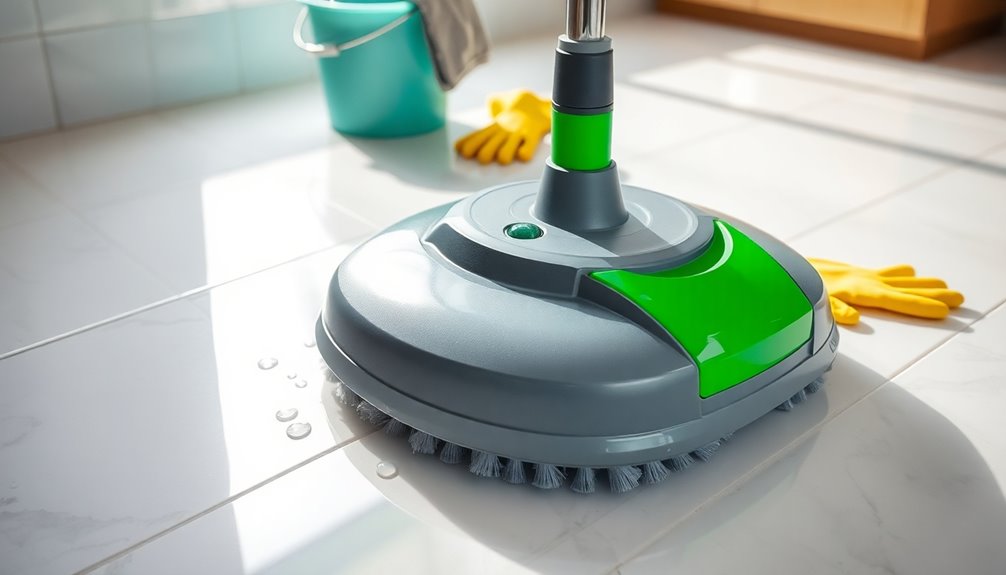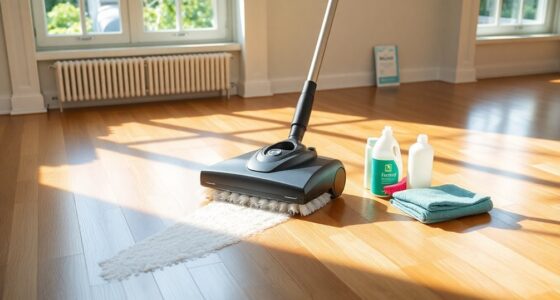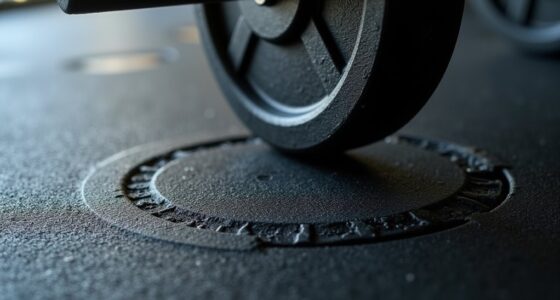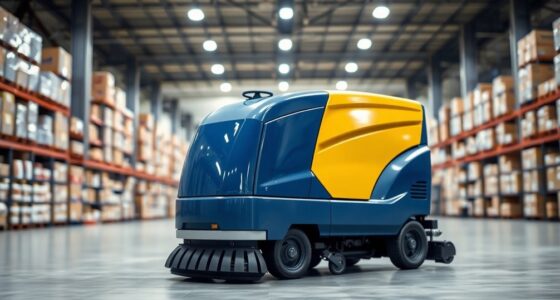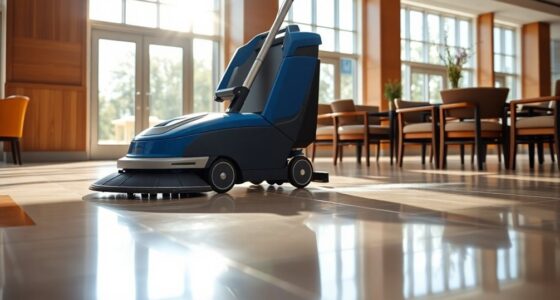To clean your floor scrubber, start by draining the recovery tank after each use to prevent odors and mildew. Rinse the tank and clean the debris tray thoroughly. Make certain to inspect and clean the squeegee assembly for even water distribution. Maintain pad drivers or brushes by rinsing them well and checking for debris. Finally, check battery water levels and guarantee proper upkeep. Want to know more about detailed maintenance steps?
Key Takeaways
- Drain the recovery tank after each use to maintain hygiene and prevent odors from mildew and sludge buildup.
- Rinse the recovery tank with clean water regularly to eliminate residues and improve air quality.
- Clean and empty the debris tray after every use to prevent blockages and ensure peak suction.
- Inspect and rinse cleaning pads or brushes thoroughly after use to prolong their lifespan and maintain effectiveness.
- Check battery water levels regularly, adding distilled water as needed, and ensure batteries are charged fully after each use.
Importance of Regular Cleaning

Regular cleaning of your floor scrubber is essential for maintaining its performance and ensuring your floors look their best. When you neglect this task, you'll likely encounter floor scrubber problems like ineffective water pickup, which hampers your cleaning performance.
Implementing daily maintenance routines, such as rinsing tanks and cleaning squeegees, not only boosts effective cleaning but also extends the life of your equipment. By prioritizing proper maintenance, you can prevent mold and mildew buildup, eliminate odors, and reduce the risk of unexpected breakdowns. Additionally, automated features in modern cleaning equipment can significantly enhance efficiency and ease of use.
Consistent cleaning helps you identify small issues early, promoting proactive maintenance and minimizing wear and tear. Ultimately, a well-maintained floor scrubber contributes to a cleaner, safer environment.
Step-by-Step Guide to Cleaning a Floor Scrubber

Cleaning your floor scrubber regularly is crucial for maintaining its performance.
Start with daily maintenance steps to keep it running smoothly, then focus on cleaning specific components for ideal results.
Let's go through the process to guarantee your machine stays in top shape.
Daily Maintenance Steps
To keep your floor scrubber in top shape, begin daily maintenance right after each use. Follow these important steps:
| Step | Action |
|---|---|
| 1. Drain Recovery Tank | Prevent sludge buildup and odors. |
| 2. Rinse Recovery Tank | Eliminate remaining contaminants and mildew. |
| 3. Clean Debris Tray | Avoid blockage in the tank inlet for peak performance. |
| 4. Clean Squeegee | Protect from chemical damage and guarantee even water distribution. |
| 5. Check Pads and Brushes | Remove debris to maintain scrubbing effectiveness. |
Cleaning Components Guide
While maintaining a floor scrubber may seem intimidating, understanding how to clean its components can greatly enhance its performance and longevity.
Start by draining the recovery tank after each use to prevent sludge buildup and odors. Rinse it thoroughly with clean water to eliminate any lingering smells.
Next, clean the debris tray daily to avoid blockages, ensuring peak performance.
Don't forget to rinse and wipe down the squeegee assembly after every use; this protects it from chemical damage and prevents streaking.
Finally, regularly inspect and clean the brush or pad, starting each day with a fresh one for the best scrubbing results. Additionally, regular maintenance can help prevent operational issues and extend the lifespan of your equipment.
With proper care, your cleaning equipment will serve you well for years.
Draining the Recovery Tank
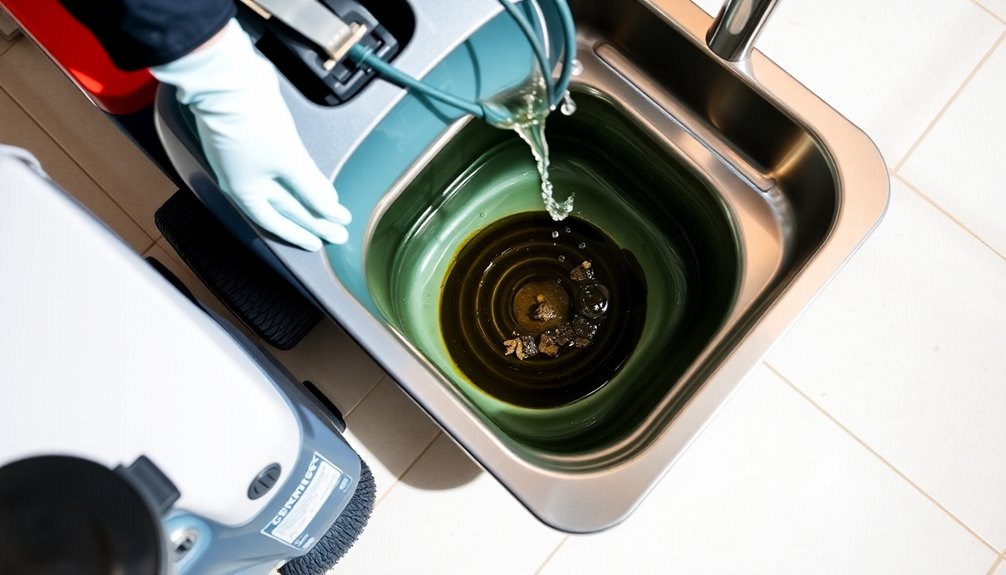
Draining the recovery tank after each use is vital for maintaining hygiene and preventing unwanted odors.
To do this, simply use the drain hose or empty the recovery tank directly into a mop drain. This not only helps you dispose of dirty water effectively but also guarantees your floor scrubber remains clean and safe.
Regularly draining the recovery tank helps eliminate the risk of mildew and prevents sludge buildup, which can hinder peak performance.
Before and after draining, check the tank for any debris or blockages.
This simple maintenance step is important for guaranteeing the overall cleanliness and efficiency of your floor scrubber, allowing it to perform at its best during future cleaning operations.
Rinsing the Recovery Tank

After you've drained the recovery tank, rinsing it out is the next important step to maintain a clean and efficient floor scrubber. Use clean water and a hose to thoroughly rinse the upper tank and sidewalls. This process helps eliminate odors, mold, and prevents the buildup of sludge and bacteria, guaranteeing peak performance. Regular rinsing is essential for hygiene and extends your equipment's lifespan.
| Step | Purpose | Benefit |
|---|---|---|
| Rinse Tank | Remove residues | Prevent mildew buildup |
| Use Clean Water | Enhance hygiene | Improve air quality |
| Routine Maintenance | Extend lifespan | Guarantee effective cleaning |
Make it a habit to rinse the recovery tank after each use!
Cleaning the Debris Tray
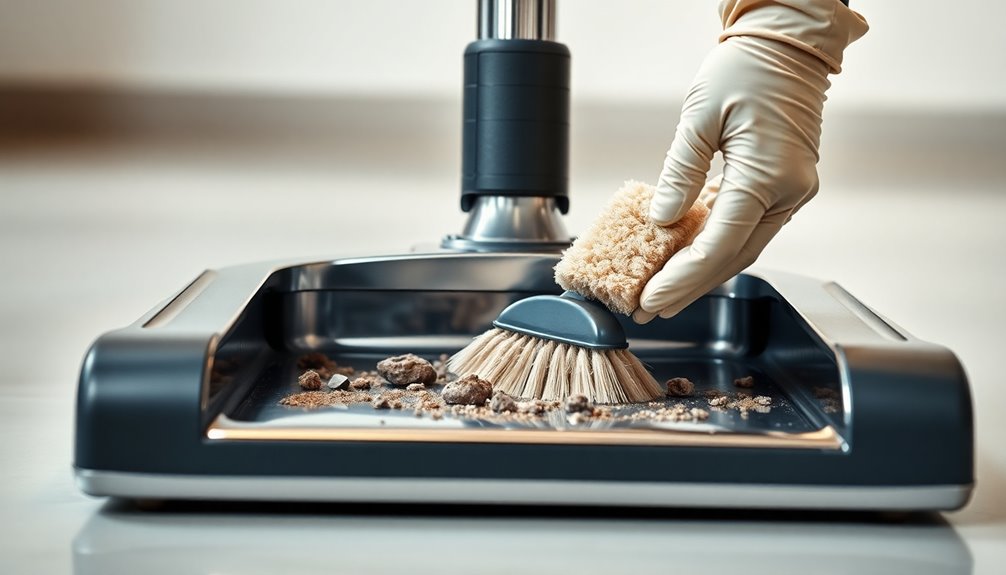
Cleaning the debris tray daily is essential for keeping your floor scrubber running smoothly.
By removing small to medium-sized debris after each use, you prevent blockages that can hinder performance.
Let's go over the simple steps to clean the tray effectively.
Importance of Daily Cleaning
Since a clean debris tray is essential for your floor scrubber's performance, it's important to make daily cleaning a priority.
Regularly emptying and cleaning the debris tray not only guarantees peak suction performance but also enhances the overall cleaning effectiveness of the machine.
Neglecting this task can lead to increased wear on components, raising maintenance costs and shortening the scrubber's life span.
Additionally, a clean debris tray promotes clean hygiene and prevents unpleasant odors from developing in your cleaning system.
- Prevents blockage in the recovery tank inlet
- Reduces the risk of larger debris clogging the drain
- Maintains peak performance without interference from accumulated debris
Steps to Clean Tray
To guarantee your floor scrubber operates at its best, follow these simple steps to clean the debris tray effectively.
Start by emptying the debris tray after each use to prevent blockages that can hinder peak performance.
Next, rinse the tray thoroughly to remove any remaining debris, ensuring a hygienic cleaning environment.
Regularly inspect the tray for wear and tear, and replace it if it's damaged or ineffective.
After cleaning, make sure the tray is properly seated and secured to avoid any operational issues during your next cleaning session.
Daily cleaning of the debris tray is recommended to prevent larger debris from clogging the drain and to maintain efficient water pickup for your floor scrubber.
Inspecting and Cleaning the Squeegee Assembly

After every use of your floor scrubber, it's vital to inspect and clean the squeegee assembly to maintain its efficiency.
Start by removing the squeegee assembly for a thorough cleaning. Rinse it with clean water to eliminate any debris and prevent chemical damage. Wipe down the squeegee blades to confirm they're free of residue, which is imperative for peak water pickup.
Make certain to regularly:
- Inspect the squeegee blades for signs of wear and tear.
- Replace damaged blades to guarantee top performance.
- Keep the assembly clean to prevent streaking and uneven water distribution.
Regular maintenance of the squeegee assembly not only enhances your scrubber's performance but also prolongs its lifespan.
Maintaining the Pad Driver or Brush

Keeping your pad driver or brush in top condition is essential for ideal floor cleaning performance. After each use, remove the pad driver or brush to inspect for debris buildup.
Rinse them off with hot water using a powerful garden nozzle to clean away dirt and extend their lifespan. Each day should start with a clean pad or brush to achieve the best scrubbing results and prevent performance issues.
Regularly check for wear—replace pads when they lose about 50% of their weight and thickness, and verify brushes aren't packed with debris or have bristles that are too short.
Finally, store cleaned pad drivers or brushes properly by hanging them to dry, avoiding contact with the machine's full weight to prevent damage.
Checking and Caring for Batteries

Maintaining the pad driver or brush is only part of guaranteeing your floor scrubber operates effectively; checking and caring for the batteries is just as important.
Regular maintenance of your batteries will greatly enhance performance and longevity.
- Check water levels in the battery compartment and add distilled water if low, guaranteeing the plates are clean and covered by no more than half an inch.
- Charge your batteries fully after each use, avoiding opportunity charging to prevent overheating.
- Inspect batteries regularly for wear, corrosion, or damage, and replace them promptly.
Additionally, keep the battery compartment clean and free of debris to guarantee proper ventilation.
This diligence will help you maintain ideal battery performance and extend their lifespan.
Final Steps for Proper Maintenance
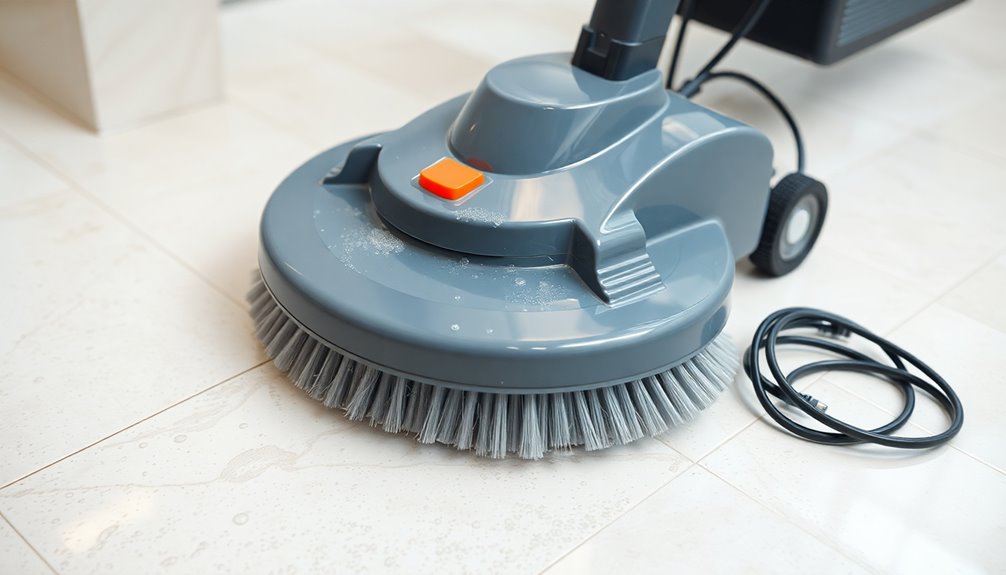
How can you guarantee your floor scrubber stays in top shape? Start with proper floor scrubber maintenance by draining the recovery tank after each use to prevent sludge buildup.
Rinse the dirty water thoroughly to eliminate odors and avoid mold. Next, clean the squeegee by removing it, rinsing, and wiping it down to guarantee even water distribution.
Regularly inspect and rinse the pads or brushes to remove any debris, which helps prolong their lifespan.
Finally, don't forget to check battery water levels; adding distilled water as needed will guarantee peak battery life and prevent acid leakage.
Frequently Asked Questions
How Do You Clean Scrubbers?
To clean scrubbers, start by draining the recovery tank after each use to avoid sludge and odors.
Rinse the tank thoroughly to eliminate debris and prevent mildew.
Next, clean the squeegee assembly and blades to avoid streaking.
Inspect and clean the pad driver or brushes regularly to maintain efficiency.
Finally, check the battery water levels daily and add distilled water as needed to guarantee peak performance and longevity.
How to Clean a Dirty Scrubbing Brush?
It's funny how something so small can make a big difference in your cleaning routine.
To clean a dirty scrubbing brush, remove it from the scrubber and rinse it with hot water to get rid of debris.
Using a garden nozzle or pressure washer, blast away any stubborn dirt.
Inspect the bristles for wear and let the brush dry completely.
Regular cleaning keeps it effective and prolongs its lifespan—keeping your scrubbing game strong!
How to Clean a Scrubbing Pad?
To clean a scrubbing pad, you should rinse it with hot water immediately after use.
Make sure to scrub it thoroughly to remove dirt and grime.
Once cleaned, hang the pad to dry, which'll help prevent mold and odors.
Regularly check for wear, replacing it when it's lost about 50% of its weight and thickness.
Avoid placing dirty pads under the machine's weight to maintain their shape and functionality.
How to Clean a Dirty Floor Brush?
Cleaning a dirty floor brush is like giving your trusty sidekick a revitalizing spa day.
Start by removing the brush from the scrubber; it's the first step to a cleaner future. Rinse it thoroughly with hot water using a powerful garden nozzle, blasting away debris.
Check the bristles for fraying, and rotate them weekly for even wear. Let the brushes dry completely to keep mildew at bay, and you'll keep your cleaning game strong!
Conclusion
By keeping your floor scrubber clean, you're not just maintaining a machine; you're nurturing a trusty steed that carries you through the daily grind. A well-cared-for scrubber glides like a swan over the surface, transforming chaos into order. With each cleaning session, you're polishing your path to a brighter, more inviting space. So, treat your scrubber with care, and it'll reward you with floors that shine like freshly fallen snow.
